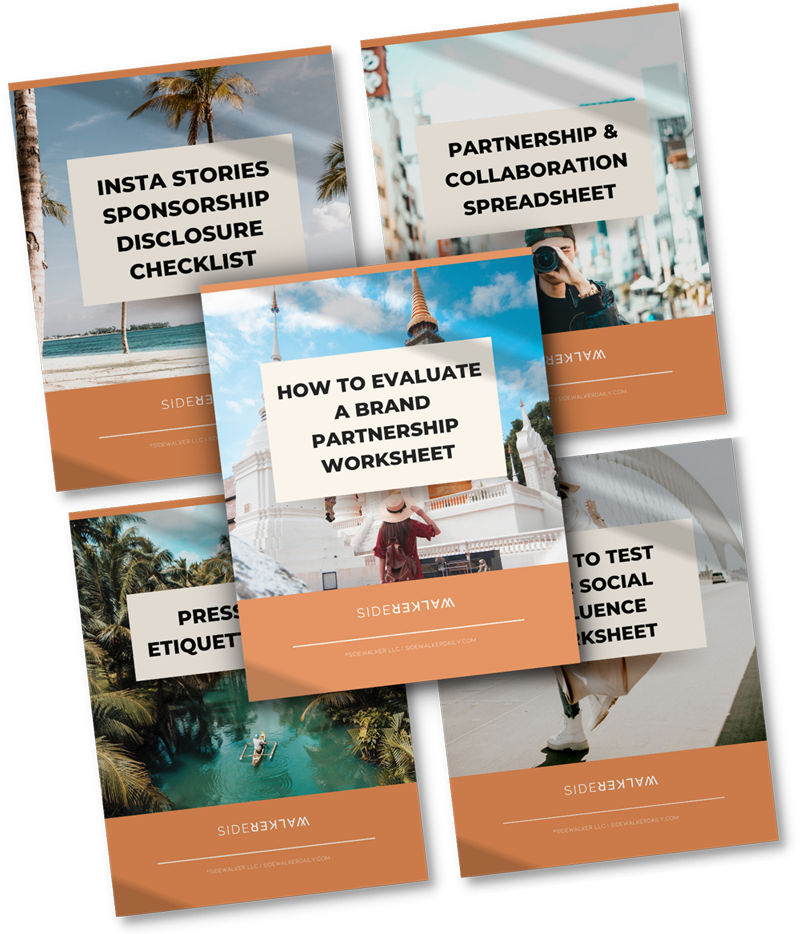If you’re ready to take your influence from a side hustlin’ hobby to a money making empire it’s time to step up your game on the business side of things. Successful businesses seem like they got there overnight but the secret is that earning enough money to sustain a business takes time, patience, and a few tricks of the trade don’t hurt.
At Sidewalker Daily, helping Creators and Influencers make money with their businesses is what we do. We also consult on the brand side of things, so we have a unique perspective into brand partnerships. If you’ve already started blogging for money or are looking to transform your influence, then it’s important have it together not only publicly but behind the scenes as well. Sending untimely thank you cards to brand partners and not keeping your financial records up to date can get you into trouble with clients and even Uncle Sam. Blogging for money is the ultimate dream so let’s go over what you can do to help make your dream a reality with our top 10 tips.
Tip 1: Know Your Hourly Rate (even if it’s just internally).
The first step in blogging for money is knowing your worth!
Influencer marketing is serious business and unless you’re doing favors for friends, accepting a brand partnership means you’re taking on a new client. When you’re just starting out, it’s easy to undervalue yourself (it happens to the best of us). If you don’t know what your time is worth then you risk accepting a brand partnership that you may actually LOSE money on.
When negotiating deals or sending out a rate sheet, consider what the brand is requesting from you and how many hours it will take you to deliver on each request.
While there’s no magic number, there should be a method to your madness—AKA you should be able to back up every price you quote. Of course, you don’t have to tell the brand partner how you came up with that number, you can just quote them a flat fee or “project quote.” The great thing is you’ll be able to confidently stand behind your price quote because you know it’s what you deserve.
One thing to keep in mind when you’re blogging for money is you may have expenses that you’ll have to incur to complete the project. For example, if you have to hire a photographer, you’ll have to factor in that cost too. Also, you will have to pay taxes on the money you earn so be prepared to say ciao ciao to a chunk of whatever amount you charge the brand.
Basically, the rate you quote isn’t actually what you’re collecting out the door because it costs money to run a business.
Let’s go over a real life example to put things in perspective. If you’re approached by a luggage company to promote their new carryon product and they request:
- 1 blog article
- 1 Instagram post
- 2 Instagram Stories
First, you will need to figure out how long it would take you to do the entire project from start to finish. Creating a list of deliverables really helps.
For example, this brand partnership may entail organizing all of the clothes and props for the shoot, figuring out locations, shooting the photos for the posts, editing images, writing the blog post, coming up with a caption for the Instagram post, uploading the blog article onto your website, posting on Instagram and Insta Stories and then finally, doing a brand recap.
Let’s just say that would take you 8 hours total from start to finish. If you’re hourly rate is $100 then you would quote the brand partners $800 for the project. How did we get that?
Here’s the calculation:
8 hours of work X $100 per hour = $800 project fee
Tip 2: Keep Track of the Hours You Spend on Every Deliverable
Even if you charge a brand a flat fee for your work, it’s important to keep track of the time you spend on each project for your internal records. If you estimated that a brand collaboration would take you in total around 8 hours and it ended up taking you 15 hours (and you didn’t dilly dally) then you know you severely undercharged for your work. It’s easy to get lost in the moment, so a simple spreadsheet to track your time works great.
Tracking your time isn’t for the brand but really to keep you in check and see how you are spending your time. Since you’re blogging for money, this will help you more accurately quote brand partners in the future. Remember blogging for money is a business – you need to get compensated for your work.
Here’s a real life example to show you what we mean:
You were hired to write a blog article about a new restaurant in Italy and tracked all your time on your partnership and collaboration spreadsheet. You quoted the brand a price for 8 hours of your time but it ended up taking you 10 hours in total. Not a big deal but by tracking your time, you can figure out ways to manage your time better during your next brand partnership or even increase your rate.
If you want to be succesful at blogging for money, you’re definitely going to go through a little trial and error phase!

Tip 3: Get a Separate Bank Account and Credit Card
Even if you don’t have a LLC or Corporation for your blog, it’s a good idea to open a separate checking account (they are usually free or a nominal cost to open and maintain) specifically for your business earnings and expenses. That way you can keep your business expenses separate from your personal finances.
You’ll not only make your accountant happy when tax season rolls around but the more organized you are when it comes to your finances, the more likely you’ll be able to reduce your tax liability. It willbe much easier to keep track of your content Creator tax write-offs.
And when you’re a business owner, saving money on your taxes really is the best feeling…promise.
Let’s go over a real life example of how to put this into practice:
You hire a photographer for $100 to edit a series of pictures you took for your recent hotel brand partnership. You would make sure to pay the photo editor from your designated “business” bank account, not your personal one since the work they performed would be a business expense.
Tip 4: Keep All of Your Documents Organized Together in one Central Location
Organization is the key to running a successful business and making money online and also saves you a lot of time in the future when you’re looking for that one document or photo you need to have on a whim. Something that takes you 5 minutes to organize now can take you over an hour to find later. You know we’re right :)
It also helps to have all your documents, photos and financial records organized in one central location so as you add people to your team, they can find things easily.
If you’re not the organized type (we totally feel you), consider hiring an assistant part time to keep your records up to date and organize your files. An awesome online tool to use is Google’s “G Suite” because you can create folders to organize all of your documents and photos online. These folders can then be shared with multiple people in your organization and even your accountant.
Tip 5: Keep Detailed Records of Your Earnings
Keeping track of the money you receive and the money you spend on your business is essential to your success.
Why? Because it helps you keep track of who has paid you for your work and who hasn’t. Having detailed financial records (and updating them regularly) is also very helpful when tax season rolls around. Trust us, trying to figure out all the payments (big and small) you have received in the last 12 months can take days and be very stressful. So to save you the headache, write them down in real time (you’ll thank us later).
Keeping tabs on all of the payments you receive also helps you understand who your most valuable brand partners are (and they may not be who you think).
Sometimes you’ll get a big brand deal from one company and then a lot of smaller deals from another company. Even though the big deal was exciting and a big payout, the smaller deals may actually add up to more in the long run (i.e. that brand partner is more valuable). Basically, keeping track helps you know who’s paying your bills. Ya feel us?
A great way to track your earnings is in an Excel Spreadsheet or Google Sheet (which is part of Google’s G Suite program we absolutely love). You can easily share or download a copy to provide to your accountant or bookkeeper.
Tip 6: Keep Track of Your Expenses
While we’re on the subject of keeping track of the money you earn, it’s just as important to keep track of the money you spend to run your business. Why? Because these expenses can potentially be deductions on your taxes.
This is when nickel and diming really comes in handy…
Also, it’s important to keep track of the expenses you incur for every brand partnership you do. It’s easy to loose track of little expenses and fees that when added up, end up being a big chunk of change. When blogging for money, you want to make sure you don’t lose money on a brand partnership.
Tip 7: Provide Detailed Recaps for Every Brand Partnership you Complete (and Keep a Copy for Yourself)
If you’re blogging for money you’re a business, so you need to stand out from your competitors. When you’re blogging for money, creating detailed recaps after every brand partnership you do is very important to your success. Not only do you let a brand know how much amazing content and measurable results they got for their money, case studies will also help you land future partnerships.
Showing your value to a brand parter will also help keep you top of mind for future partnerships.
Although sending a partnership recap may not be required in your deal…do one anyway! Recaps are a professional courtesy and won’t go unnoticed.
We also have to stress how important it is to make your partnership recaps professional and easy to digest. Sending over screenshots is just tacky. Take the extra time to format the document and add some personal design touches (they really do make all the difference).
We also suggest keeping all of your recaps organized in a folder or on Google’s G Suite because you never know when they will come in handy. A brand may ask you for a specific example of your work and with a couple of clicks you can send over a case study and voila, you’ve upped your chances of sealing the deal.
Tip 8: Stand Out By Overdelivering
Overdelivering may be the best kept secret in how to make it in industry, period. Know how much you love getting free stuff? It’s no different on the brand side of the influencer industry.
When you overdeliver on a brand partnership, you’re giving them something that they weren’t expecting (and didn’t pay for) and that will make them happy!
You’ll also stand out in a good way and people can confidently recommend you to other brands in the industry.
Being known for going above and beyond can also be in your favor when it comes down to deciding between you and another blogger for the job. In your partnership recaps, make sure to include what you agreed to do for the brand and what you actually delivered (i.e. show your worth on paper or else it may get missed)! For example:
- Agreed Upon Deliverables: 1 blog post, 2 Instagram posts, 2 Instagram stories.
- Deliverables Completed: 1 blog post, 3 Instagram posts, 5 Instagram stories.
Tip 9: After the Partnership is Over, Send the Brand Partner a Personalized Thank You Note
Sending a personalized thank you note is a definite must for brand collaborations. After you’ve sent the brand your partnership recap we suggest sending them a handwritten thank you note or small gift (depending on the level of the partnership). Many people think that sending a quick email “thank you” is ok – IT IS NOT.
Yes, an email does the job but it’s impersonal and shows a lack of professionalism. Adding extra (human) touches like personalized “thank you” notes leave a nice feeling and when other opportunities come around, you’ll be top of mind.
But wait!
Don’t forget to keep track of all the thank you notes you send! If you’re super busy it’s easy to forget if you’ve sent a note or not and you really can’t ask the brand partners, “Hey, did I send you a thank you note?”
We always suggest sending a personalized message but sometimes you just don’t have the time to think and have to break out the templates. That is OK!
If you end up using a template just add a couple of lines to make it personal. Also, don’t forget to keep track of which template you sent so if you end up working with the brand again you can make sure to switch it up with a different message.
Tip 10: Hire a Part-Time or Full-Time Assistant to Help You Run and Expand Your Business
If you’ve committed to blogging for money you may want to consider hiring an assistant. You know the saying “it takes money to make money,” well this is the perfect example. Unfortunately, you can’t do it all (unless you have magical powers we don’t know about) and you’re going to need help to grow your business at some point.
Hiring an assistant may seem like a huge step but you don’t have to hire someone full-time. You can start with having some part-time help and then slowly add more hours as your workload increases.
Finding a great assistant sounds easy right? It actually is tougher than you think, if you want to find the right fit. We don’t suggest hiring just anyone because they may actually turn out to be more work than they’re worth. You can even hire a virtual assistant to help keep your records organized or do the things you seem to never get to.
Blogging for money is the real deal. Treating your influence like a real business is the first step in turning it into one. But remember, with making money comes responsibility so take the time to give your business the TLC it deserves.
Blogging For Money
Blogging for money might be your dream job, but you have to do the work! We hope that these 10 tips for how to make money blogging for beginners help you take your Influence to the next level and monetize your work. As a quick recap, here’s what we went over:
1) Know your worth, even if it’s just internally. Figure out what your hourly rate should be to prevent yourself from losing money.
2) Keep track of your hours so you can see how much time you spend on specifc task. This will help you know what to charge.
3) Get a separate bank account for personal and business expenses to keep everything organized.
4) Keep all of your documents organized together in one central location. Ex) financial records, photos
5) Keep a detailed record of your earnings to see your progress.
6) Remember to keep track of your expenses as well – this will make tax season easier!
7) Provide detailed recaps for every brand partnership you complete so they can see how it went. It will help you stand out from your competitors and can even lead to future partnerships.
8) Try overdelivering in your blog brand partnerships. This courtesy won’t be overlooked.
9) Send a personalized thank you note after the collaboration wraps up.
10) Consider hiring an assistant. There’s a lot to do as you run your own business, and sometimes you have to spend money to make money.
Whether you’ve just begun looking into how to start blogging for money, or you’ve already started making some money but want to take it to the next level, our team at Sidewalker Daily is here to help. You can book a call with one of our coaches to talk through your strategy and come up with a specific plan for making money online.
If you’re not quite ready to take this step, we’d love to see you at one of our free trainings so you can ask your initial questions before going all in! Did you find this article helpful? Leave a comment below–we’d love to hear from you!

























